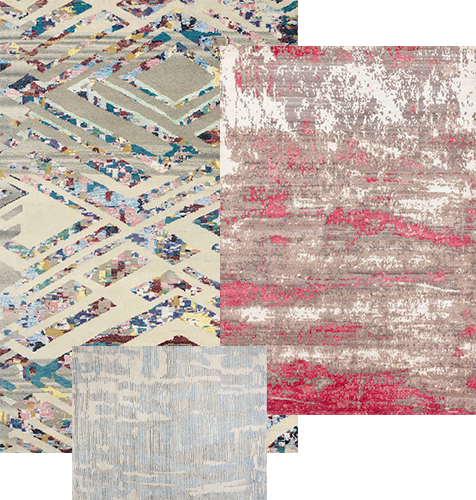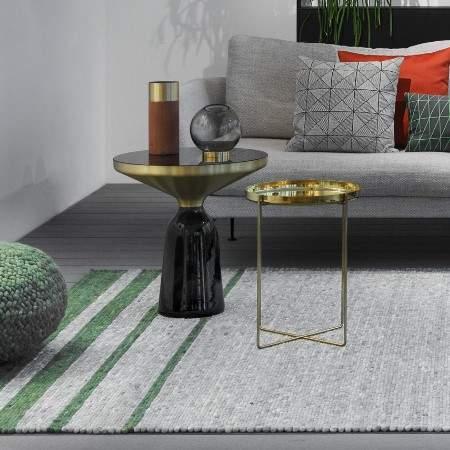
The Difference Between Hand-Knotted and Hand-Tufted Rugs
A rug adds character to a room and can be a focal point which draws the eye. When considering buying a rug you will be assessing visual style, quality and price just as you would with any item for the home. Before deciding whether a hand-knotted or a hand-tufted rug is the better option for you it is worthwhile understanding how each type of rug is made and how they differentiate.
Hand-Knotted Rugs
The technique used to make hand-knotted rugs is an ancient art form and can be extremely time consuming depending on the level of detail involved. This is a skilled trade, often using the finest wools and silks. They are completely hand crafted with a weaver using a special loom to create one knot at a time to form the intricate patterns.
The best quality rugs generally have a higher knot count per square inch of the rug. Being created by hand and so delicately designed produces a one-off product every time, adding to their value and appeal.
Oriental and Persian rugs are examples of popular types of hand-knotted rugs, which are often passed down through generations as family heirlooms.

Hand-Tufted Rugs
A hand-tufted rug is not fully made by hand, also using a mechanised tool. This tool is a small tufting gun which is used to create the design by punching it on to a backing canvas.
This style of rug uses wool yarn in its manufacturing process and the design of the rug will be drawn out on the canvas for the user of the tufting gun to trace.
This is not a skilled craft and these style of rugs can therefore be mass produced at speed.

Differences Between Hand-Knotted and Hand-Tufted Rugs
With such a marked difference in how the rugs are made there are some notable differences to look for when considering purchasing a rug. These differences can inform you whether it is hand-knotted or hand-tufted.
The Back of the Rug
By checking the bag of the rug you should quickly be able to tell the style. The quality workmanship of a hand-knotted rug will still be on show when the rug is flipped over and you will still be able to count the knots per square inch. In essence the back mirrors the front and you could use it either way round. In contrast a hand-tufted rug will have a canvas backing which is glued to hold the rug in place. Looking at the back is usually the easiest way to determine the type of rug.
The Fringe
The fringe is an essential element of a hand-knotted rug as it helps hold the rug together and prevents it unravelling. The wool is knotted in to the fringe and looks natural, with the pieces at the end left for decorative purposes. On a hand-tufted rug the fringe has no such essential purpose. The fringe is sewn or glued on to add a look of authenticity to the rug. Therefore looking at the fringe is another way to quite easily tell the difference between the two rug styles.
The Knots
When looking at the back of a hand-knotted rug you will notice the knots are not uniform. This is because they are completely hand-made, whereas with hand-tufted rugs you can expect them to be even as a result of the part-mechanised manufacturing process. The knots on a hand-knotted rug are also very tight and can last for centuries, but those on a hand-tufted rug can start to fray over time.
Value
A good hand-knotted rug is going to cost you more than a hand-tufted rug. The level of craftsmanship and the time involved to make the rug from hand will ensure a hand-knotted rug is toward the top end of the pricing scale. Yet if they are well cared for these rugs will retain their value, if not increase it over time. The fact each hand-knotted rug is an original and not mass produced can make them highly prized items. The way they are made means they can last for centuries, becoming family treasures to be passed down the generations.
A hand-tufted rug can be ideal if budget is a primary consideration or you are looking for several rugs to fit out a building. These style of rugs are made to fit the trends of the time and are largely mass produced and will not keep their value. That being said, as with most products, there are differences in quality within the hand-tufted rugs available on the market. Superior hand-tufted rugs made from wool can be thicker and make a suitable rug for parts of the house where you see more footfall.
Just as hand-tufted rugs can vary in quality it should be pointed out the same can apply to hand-knotted rugs. The value of these rugs will increase with the intricacy and density of the knots in the design. Yet there are poor quality rugs as well as rugs of exceptional quality. Wool which is of poor quality to begin with or which was highly processed can affect the quality of the end product. The type of knotting can also determine quality, as using what is called a false knot is a way of reducing the considerable time often needed to make a hand-knotted rug, although at the expense of its quality.

Choosing Your Rug
As can be seen in the large part a hand-knotted rug is superior in quality to a hand-tufted rug. However, other factors such as cost and where the rug will be located and how much footfall it will see can determine the priorities when considering which type of rug to buy. Hand-tufted rugs are not built to last like their hand-knotted alternatives. However, this may not be an issue if you like to regularly replace your rugs and keep up with the trends of the day. A hand-tufted rug may not become a valuable collectors item, but a good quality one can still grace a home and brighten up any room.
A quality artisan made hand-knotted rug will be durable, will not shed easily and has a potentially endless lifetime. A professional clean once a year should do the trick to protect this prospective heirloom. A hand-knotted rug can also be over-dyed if it starts to fade and will not need replacing every few years, resulting in less waste being sent to landfill. Yes they can be expensive, but the intricate nature of the creative process and patterns involved can take months to complete. In contrast a hand-tufted rug can be mass-produced very quickly, with the resulting savings on production time making them a cheaper alternative.




